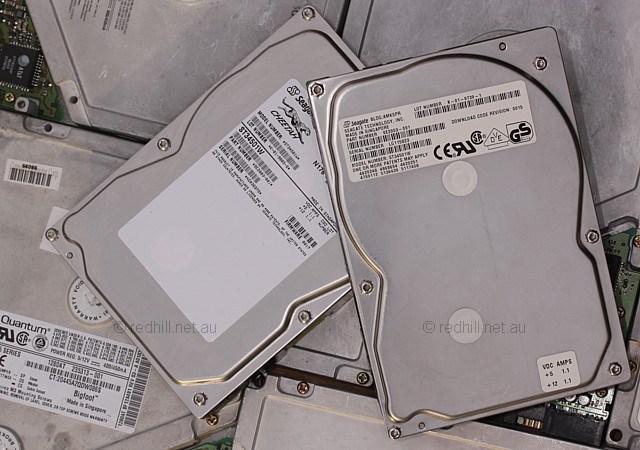
Photo: Red Hill.
Seagate Cheetah Family
The Cheetah was easily the world's fastest hard drive. For a long time there was nothing else spinning at 10,000 RPM, and nothing else even came close to the data transfer rate the Cheetah produced: up to 21.3 megabytes a second. By way of comparison, a top-class 3 or 4GB IDE drive drive from the same era produced less than 7MB sec. The best IDE drives could not match Cheetah 1 transfer rate performance until nearly three years later when the third generation 7200s arrived, and they will probably never match its access times.
The real highlight of the Cheetah, however, was its extraordinary access times: the 7.7ms average seek was very special indeed and the 3.0ms latency that only a 10,000 RPM drive can produce was unique. At under 11ms total average access time, the 1997 Cheetah was streets in front of anything else on the market. For comparison, even five years later the fastest-seeking IDE drives were in the 13ms class.
At around two thousand dollars per unit when it first came out, the original Cheetah was hardly cheap, but pairing our 4.5GB Cheetah with a 686-200 or a K6-233 produced outstanding results — easily faster than any IDE-based system, even a much more expensive Pentium II (at that time the ultimate CPU). There were two original Cheetah models: 4.5GB and 9.1GB. Notice that the seek time is very slightly higher for the 9GB drive because of the added mass of the extra heads.
The series 2 Cheetah was even faster. The data rate went up to an incredible 231M/bit sec, and the seek time was an astonishing 5.2ms — this was roughly half the seek time of most contemporary drives. If serious high-performance was your aim, and you were willing to part with around $1000 more than you'd pay for an IDE drive, then a Cheetah was a great idea. It cost about the same as the difference between a top-notch Socket 7 CPU and a high-end Slot 1 part, and for business uses it was much more effective. Even for games it was worth considering. And if you were running a big server or an A/V workstation, the Cheetah had no peer.
Illustration: a collage of opposites. Unquestionably the fastest hard drive ever made on introduction, the original Cheetah (right) was also perhaps the plainest, least memorable looking drive ever made. Seagate apparently felt the same way as, not long afterwards, the exact same drive (left) started shipping with a new, fancier-looking label. Where the Cheetah was the ultimate cost-no-object fast hard drive, the Quantum Bigfoot was the reverse: not much was cheaper, and nothing was slower.
| Cheetah 1 | Performance | 1.38 | |
| Data rate | 177 Mbit/sec | Spin rate | 10,033 RPM |
| Seek time | 7.7ms | Buffer | 512k |
| Platter capacity | 1.14GB | Interface | Fast wide SCSI |
| Read channel | PRML | Head technology | MR |
| ST-34501 | 4.55GB | 8 heads | 1/3 height |
| ST-19101 | 9.1GB | 16 heads | ½ height |
| Cheetah 2 (1998) | Performance | 1.63 | |
| Data rate | 231 Mbit/sec | Spin rate | 10,025 RPM |
| Seek time | 5.4ms | Buffer | 1MB |
| Platter capacity | 1.52GB | Interface | Ultra SCSI |
| ST-34502 | 4.55GB | 6 heads | 1/3 height |
| ST-39102 | 9.1GB | 12 heads | 1/3 height |
| ST-118202 | 18.2GB | 24 heads | ½ height |
| Cheetah 3 (1999) | Performance | 1.74 | |
| Data rate | 308 Mbit/sec | Spin rate | 10,016 RPM |
| Seek time | 5.2ms | Buffer | 1MB |
| Platter capacity | 3GB | Interface | Ultra 160 |
| ST-318203 | 18.2GB | 12 heads | 1/3 height |
| ST-136403 | 36.4GB | 24 heads | ½ height |